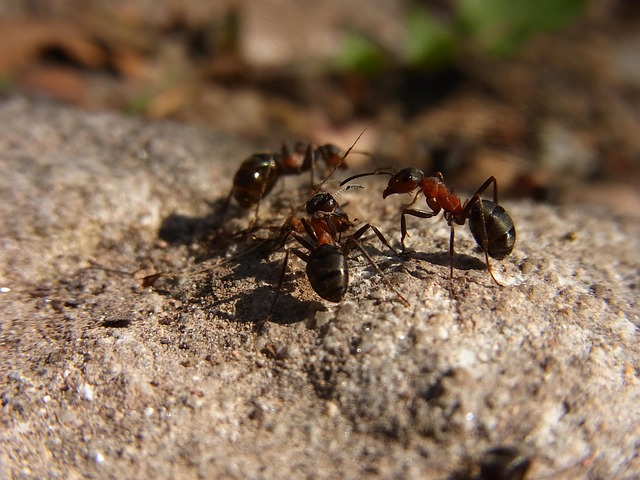Professional ant exterminators utilize advanced technologies like tracking systems, heat sensors, drones, thermal imaging cameras, and remote sensing techniques to accurately detect and target ant colonies, revolutionizing extermination methods. These innovations improve detection accuracy, enable more precise treatments, reduce chemical use, and enhance overall effectiveness in professional ant extermination efforts.
Ant trails, intricate networks that guide these persistent intruders, pose a significant challenge for professional exterminators. Traditional methods, while effective, often rely on labor-intensive techniques and limited chemical interventions. However, innovative technologies are transforming ant management. This article explores cutting-edge tools and strategies that offer more precise, efficient, and environmentally friendly solutions to combat ant trails. From advanced detection systems to sophisticated treatment techniques, these innovations empower professionals to deliver superior ant extermination services.
Understanding Ant Trails: The Professional Exterminator's Perspective
Ant trails, invisible to the untrained eye, are complex networks that ants use for communication and resource gathering. From a professional ant extermination perspective, understanding these trails is paramount in effective ant management. Exterminators employ specialized techniques to map out trail patterns, which can indicate the presence of colonies and their locations. By following the pheromone-laced paths, professionals can pinpoint the main nest, where the queen resides, and launch targeted treatments.
This insight allows for tailored approaches, using innovative technologies like advanced tracking systems, heat sensors, and even drones to locate and eliminate ant trails efficiently. In the realm of professional ant extermination, staying ahead of these intelligent creatures requires embracing cutting-edge methods, ensuring faster response times and more successful eliminations.
Traditional Methods vs. Innovative Technologies for Trail Detection
In the realm of professional ant extermination, the approach to trail detection has evolved significantly from traditional methods to innovative technologies. Historically, pest control professionals relied on manual inspections and visual cues to identify ant trails, a time-consuming and often imprecise process. This involved meticulously searching for pheromone traces left by ants, which could be easily overlooked in complex environments.
Innovative technologies have since revolutionized trail detection, offering more efficient and accurate solutions. Advanced tools like thermal imaging cameras can now visualize heat signatures left by ants, making trails more tangible. Additionally, remote sensing techniques using drones or satellite imagery provide a bird’s-eye view, facilitating the identification of extensive ant networks. These cutting-edge methods not only enhance detection but also enable professionals to devise more targeted treatment strategies, ensuring better outcomes in ant extermination efforts.
Advanced Tools and Techniques for Effective Ant Treatment
In the realm of professional ant extermination, advanced tools and techniques have emerged, revolutionizing how we identify and mitigate ant trails effectively. Modern technology offers innovative solutions that go beyond traditional methods, ensuring more precise and efficient control. For instance, remote sensing technologies like drones equipped with high-resolution cameras can scout large areas, detecting ant trails hidden from direct observation. This aerial perspective provides a comprehensive view of the colony’s activity, aiding in strategic planning for treatment.
Furthermore, integrated sensor systems and IoT (Internet of Things) devices are being utilized to monitor environmental conditions along ant trails. These sensors detect moisture levels, temperature changes, and pheromonal signals, providing real-time data that helps identify active trails and the proximity of colonies. This intelligence allows pest control professionals to deploy targeted treatments with greater accuracy, minimizing the use of chemicals and reducing environmental impact.
Case Studies: Successful Implementation of Innovative Extermination Strategies
In recent years, the field of professional ant extermination has witnessed a paradigm shift with the advent of innovative technologies. These cutting-edge strategies have proven highly effective in identifying and treating ant trails, offering solutions that are both eco-friendly and efficient. Case studies from various regions highlight the success of implementing these new techniques. For instance, researchers in urban areas have utilized advanced pheromone tracking systems to map out complex ant networks, allowing for targeted treatments that disrupt the entire colony without harming non-target species.
Another noteworthy approach involves the use of remote sensing and artificial intelligence to detect changes in ant behavior patterns, indicating the presence of trails or colonies. This technology enables professionals to proactively identify problem areas and employ tailored extermination methods, such as controlled releases of biopesticides that specifically target ant pests while minimizing environmental impact. These case studies demonstrate the potential for innovative technologies to revolutionize professional ant extermination practices, leading to more effective and sustainable solutions.
The evolution of ant trail detection and treatment methods, driven by innovative technologies, offers professionals in ant extermination a powerful arsenal. From advanced tools enhancing accuracy to case studies showcasing success, these modern strategies provide effective, efficient solutions for even the most challenging infestations. By adopting these cutting-edge techniques, exterminators can ensure superior customer satisfaction and maintain a competitive edge in the industry of professional ant control.
